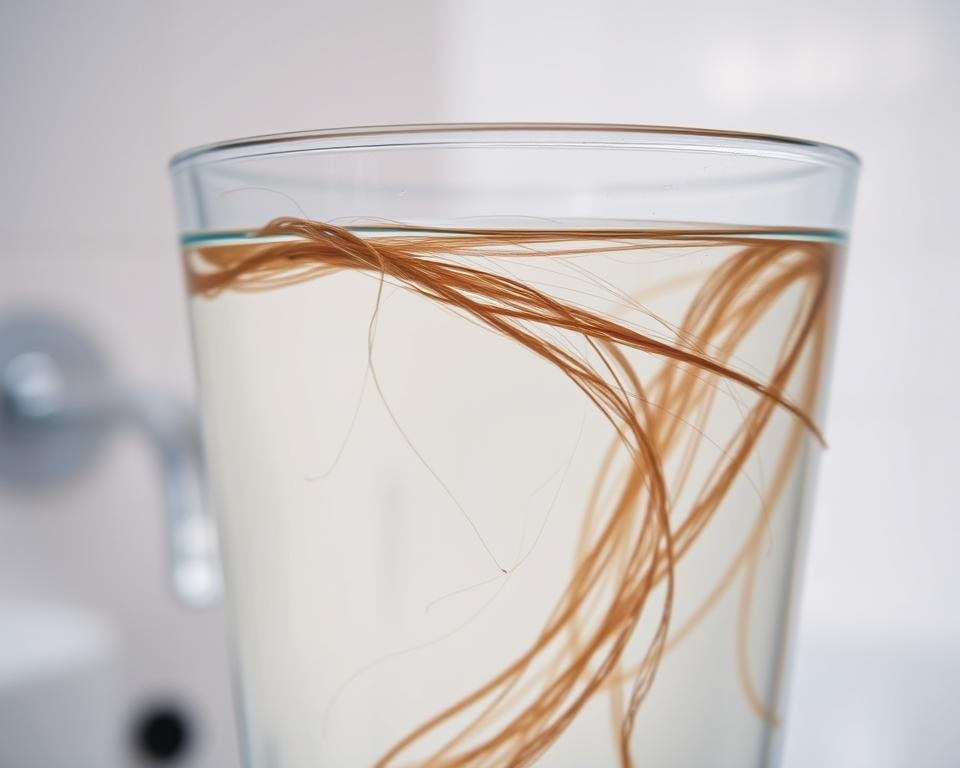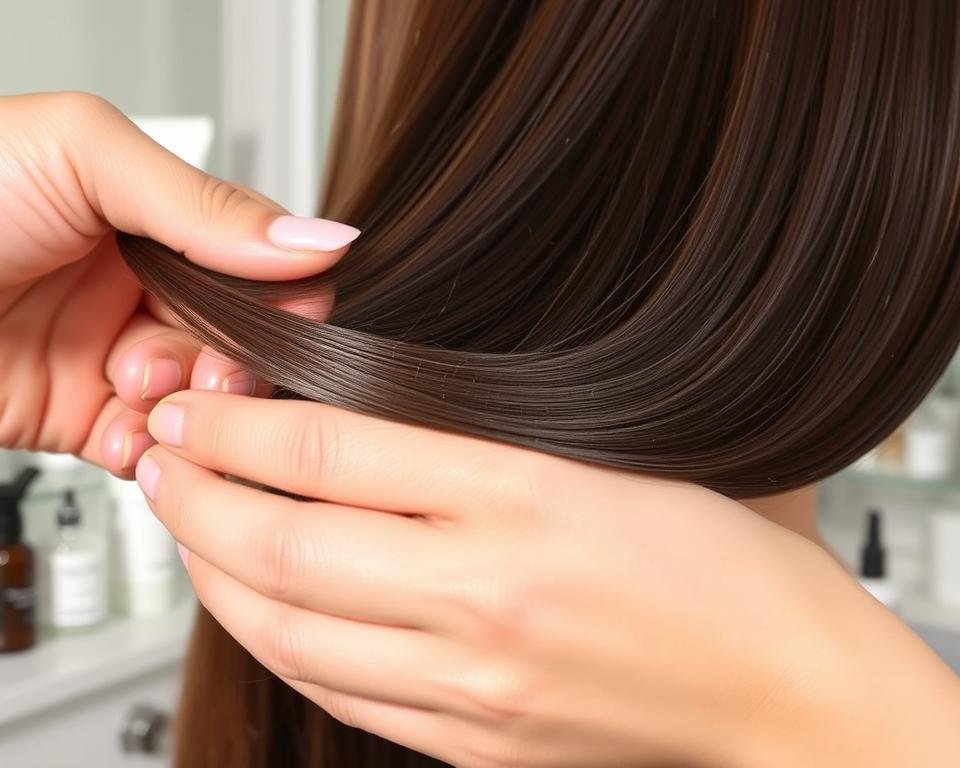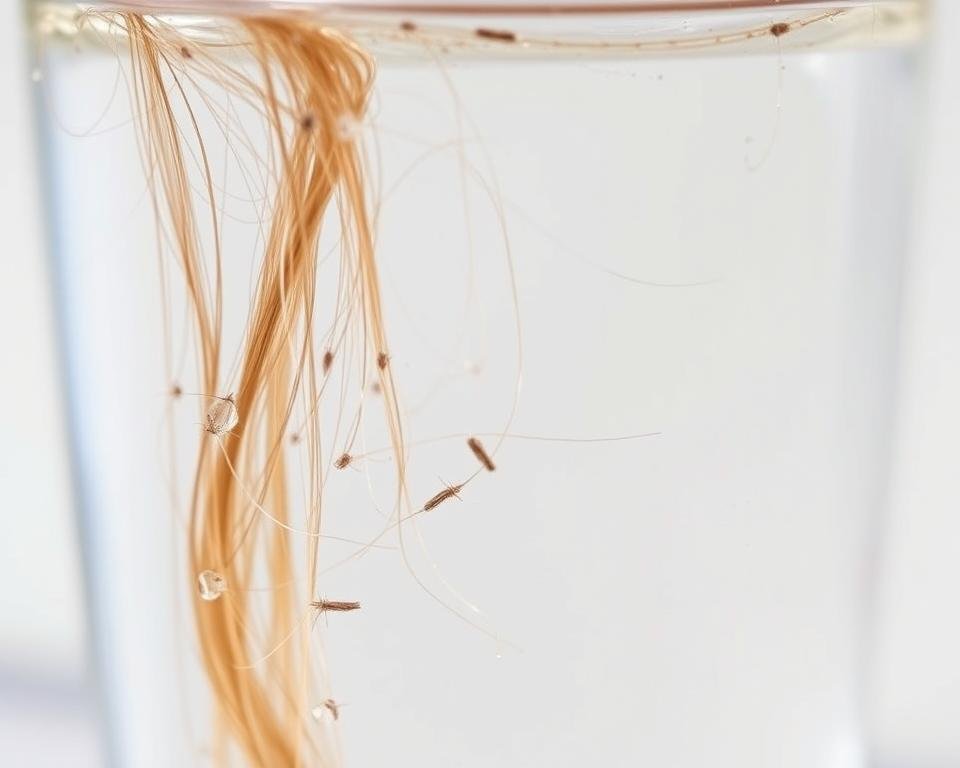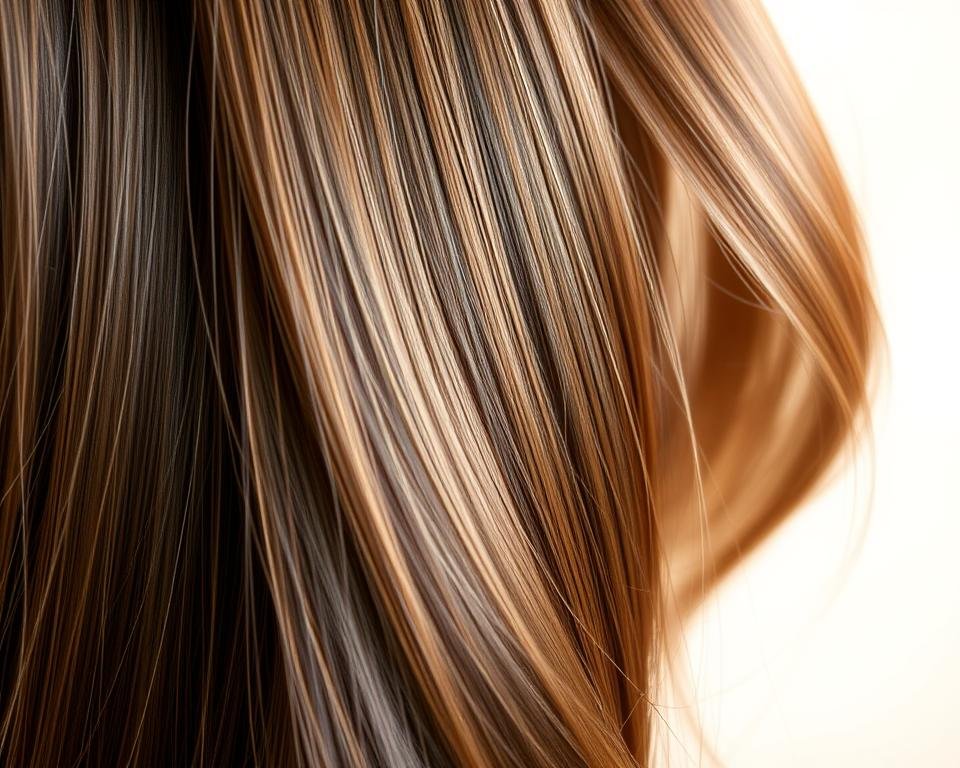Hair health depends on four main things: shine, elasticity, moisture, and strength. These elements help your hair look healthy and shiny. This article will show you 5 easy ways to check your hair’s health.
One way is the float test to see if your hair is moist. You can also check if your hair is elastic and bouncy. The humidity test helps find out if your hair gets frizzy and how well it holds moisture.
Looking at how your hair grows is another sign of health. Color and how easy it is to detangle also matter. By knowing these signs, you can keep your hair healthy and looking great.
Understanding the Signs of Healthy Hair
Many people strive for healthy hair. But, it can be hard to know what healthy hair looks like. Knowing the signs of healthy hair helps you take care of your hair better.
Shine and Smoothness
Healthy hair shines and feels smooth. When the hair’s outer layer is flat, it reflects light well. This makes the hair look glossy and healthy.
“Healthy hair should possess a natural sheen, and the texture should feel smooth and consistent from root to tip.”
Healthy hair also has natural oils evenly spread. If your hair looks dull, dry, or frizzy, it might be damaged or dehydrated.
Checking your hair’s shine and smoothness tells you a lot about its health. To keep your hair shiny and smooth, get regular trims, use gentle hair care, and eat well.
The Float Test: A Quick Hair Health Experiment
One simple way to check your hair’s health is the float test. This quick test shows how much moisture your hair has and if its cuticle is okay. Just take a few clean, dry hair strands and put them in a bowl of water.
If the hair floats or barely touches the water’s surface, it means your hair cuticle is healthy. This shows your hair has low porosity. It’s hard for water and products to get in because the cuticle is tightly bound.
But, if your hair sinks, it might mean your cuticle is damaged. This lets water easily get into the hair shaft. Hair that sinks is usually dry and frizzy because it has high porosity.

The float test is a quick way to see if your hair keeps moisture well. Keeping moisture in is key for strong, shiny hair. Knowing your hair’s porosity helps you choose the right products and styling methods to keep your hair looking great.
Assessing Elasticity and Bounce
Healthy hair stretches and snaps back easily. To check, gently pull a wet hair strand. It should stretch a bit before bouncing back. Hair that breaks easily is hard to style and keep in shape.
Elasticity and Style Retention
Bouncy and voluminous hair is a sign of health. Damaged hair looks flat and stiff. Healthy hair stretches up to 30% of its length before snapping back.
Curls are naturally more elastic than straight hair. But, as we age, hair loses moisture and elasticity. Heat styling, coloring, or chemical treatments also harm hair elasticity.
If your hair quickly returns to shape after stretching, it’s healthy. But, if it breaks before stretching 30%, it’s damaged. Damage to the hair cortex often causes low elasticity.
“Maintaining moisture balance in the hair structure is essential for improving elasticity and preventing breakage or excessive stretchiness.”
To fix low elasticity, use a Restore and Shine Hair Masque twice a week for two weeks. Then, do weekly maintenance treatments. Be gentle when testing hair elasticity, as it’s most fragile when wet.
Regular conditioning and deep conditioning treatments help. Choose styling products that improve hair elasticity. This way, you can keep your hair healthy, bouncy, and style-retaining.

The Humidity Test: Evaluating Frizz and Porosity
Your hair’s reaction to humidity can tell you a lot about its health. If frizz shows up right when it gets wetter and warmer, it means your hair is very porous. This is because the cuticles are damaged and can’t keep moisture out. On the other hand, healthy hair stays smooth and closed, keeping its style even when it’s humid.
The hair porosity test is a simple way to check how well your hair takes in and holds moisture. By seeing how your hair reacts to water, you can figure out if it’s low, medium, or high porosity. Low porosity hair might have trouble soaking up moisture, leading to frizz and humidity problems. High porosity hair, on the other hand, can get too wet, causing damage to the cuticles and making styling hard.
Using products that act as a shield against humidity can help keep your hair sleek, even in humid conditions. Knowing what your hair needs in terms of porosity is key to having a frizz-free, strong mane.

“Healthy hair, with a smooth, closed cuticle, is able to maintain its natural style in humid conditions, resisting frizz and flyaways.”
Identifying Healthy Hair Growth
Healthy hair growth shows your hair’s overall health. If your hair grows slowly or not at all, it might be damaged. Healthy hair grows about half an inch each month, following its natural cycle.
Not seeing hair growth could mean too much breakage and hair growth problems. This is when new hair breaks off before it’s fully grown. Strengthening your hair can help it grow healthier and longer.

Things like heat styling, age, scalp issues, and daily wear can harm your hair. Using the right hair care products is key. This includes moisturizing masks, leave-in treatments, and cuticle sealers to make your hair stronger and longer.
“Healthy hair may have minimal frizz, split ends, roughness, and a lack of luster, while moisturized hair exhibits shine, indicating good health.”
By noticing signs of healthy hair growth, you can fix problems early. This helps keep your hair looking great and feeling strong.
how to tell if your hair is healthy
Checking your hair’s health involves looking at shine, elasticity, moisture, growth, and how it handles humidity. Simple tests at home can show you how your hair is doing. This helps you choose the right haircare.
Shine and Smoothness show if your hair is healthy. Moisturized hair reflects light well, giving it a natural shine. It should also feel smooth when you run your fingers over it, not rough.
The Float Test checks your hair’s porosity. Healthy hair sinks slowly in water. If it sinks fast, it might be dry and damaged.
Checking your hair’s elasticity and bounce is another way to see if it’s healthy. Good hair stretches and goes back to its shape. This means strong bonds and healthy hair.
Seeing how your hair acts in humid weather also tells you something. Healthy hair stays smooth in damp air. Dry, damaged hair gets frizzy and hard to manage.
Knowing these signs of determining hair health, evaluating hair condition, and doing regular hair health self-assessments helps. You can keep your hair strong and shiny.
The Static and Frizz Factor
When your hair fights static and frizz, it’s a sign it’s dry. Healthy hair, full of moisture, doesn’t get static or frizzy easily. Fixing these hair problems can make your hair smooth and easy to handle.
Moisture and Static Control
Dryness causes hair static and frizz. When hair loses moisture, its cuticles lift. This lets moisture in, making hair fluffy and unruly.
Also, dry hair has more friction, leading to static. This makes hair stand up.
To fight these issues, add moisturizing products to your routine. Hair oils, deep conditioning masks, and leave-in treatments with coconut can restore moisture. This reduces static and frizz. Also, use humidity-resistant hairspray and switch to silk or satin pillowcases to lessen static problems.
Keeping your hair’s moisture balanced can reduce hair static issues and frizz. This leaves your hair smooth, shiny, and easy to manage.
Assessing Scalp Health and Oil Production
Your scalp’s health is key to your hair’s condition. Too much oil can make your hair greasy, while too little can cause dryness and flakes. It’s important to keep your scalp’s oil production balanced for healthy hair.
Look for signs of a healthy scalp, like no greasiness between washes. A healthy scalp is pink, well-hydrated, smooth, and free of flakes or redness. But, an unhealthy scalp might show hair loss, breakage, dandruff, inflammation, or even acne or cysts.
Things like hormonal imbalances, diet, genetics, stress, and medication changes can harm your scalp. A gentle hair care routine, the right products, and scalp treatments can help. This can improve your scalp’s health and oil production for vibrant hair.



